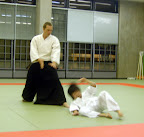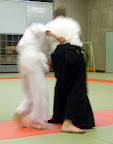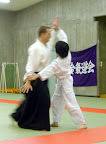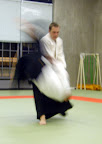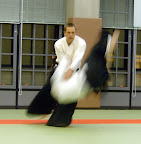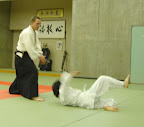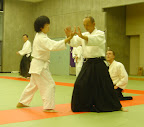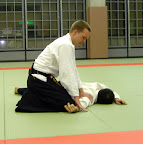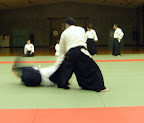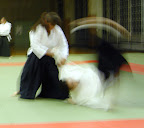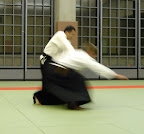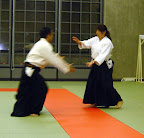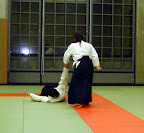Saturday and Sunday we continued practicing for Tokyo. We got into our pairs and tried to polish up our routines. After being timed with a stopwatch, I realized that our set was too short. No worries, we just added 3 more techniques. My guinea pig, er, partner was ready for anything. We practiced a few wazas 20-30 times each and then performed the entire routine. Like a dress rehearsal.

Here we are doing tenchinage (天地投げ). I think here I'm doing better. Sensei said I need to bring my "heavenly" hand up more. This brings the aite (相手) closer to me.
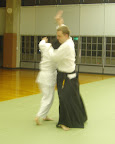
Different technique, but same problem. Here's iriminage (入り身投げ). My technique looks really sloppy because I don't pause half a second and bring my arm a bit higher. I need to wait and let my partner's momentum (相手の推進力) bring his head into the crux of my arm.
In this case, I feel like the partner's head is in my way. Impeding my movement, as it were. Senesi didn't say it directly, but I think that problem will vanish if I move properly and with a certain fluidity of motion.

Now this is tenchinage done right. Look at sensei's arm-his hand sword (手刀) is cutting down to the mat. The uke's body is completely bend backwards, like a bow strung.

Sensei worked with a little boy on Sunday. I thought I would include these pics because 1. they're pretty cute and 2. they provide a great model. This kid just effortlessly spins and flips with an amazing ease. His limber, little body reacts so naturally and smooth to sensei's prodding.
Ah, one final note. Sunday, two of my co-workers visited our dojo and had their first practice. I spent some time with the Canadian guy working on tenkan (転換)and irimitenkan (入り身転換). Interesting experience for me. I practice aikido in Japanese, so it was a bit of a challenge to think about certain movements in English. This blog has helped me articulate certain ideas about aikido. And thanks for reading my attempts at articulation.
Next week is Tokyo! I promise to get some shots and bring you the story as I recover from the festivities!
























